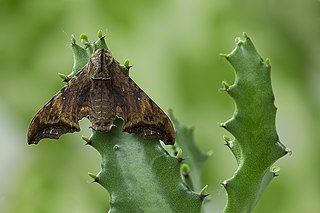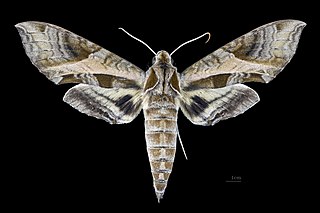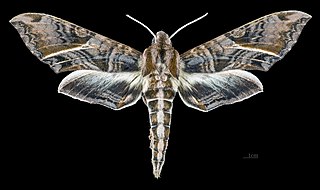
Eumorpha anchemolus, the anchemola sphinx moth, is a moth of the family Sphingidae. The species was first described by Pieter Cramer in 1780.

Eumorpha capronnieri is a moth of the family Sphingidae first described by Jean Baptiste Boisduval in 1875.

Eumorpha elisa is a moth of the family Sphingidae.

Eumorpha phorbas is a moth of the family Sphingidae.

Eumorpha typhon, the Typhon sphinx, is a moth of the family Sphingidae. The species was first described by Johann Christoph Friedrich Klug in 1836.

Eumorpha vitis, known as the vine sphinx, is a moth of the family Sphingidae.

Xylophanes docilis is a moth of the family Sphingidae.

Xylophanes resta is a moth of the family Sphingidae.

Eumorpha adamsi is a species of moth in the family Sphingidae. It was described by Walter Rothschild and Karl Jordan, in 1903, and is known from Venezuela, Brazil, Bolivia and Paraguay but is probably present throughout most of South America.

Isognathus leachii is a moth of the family Sphingidae.

Nyceryx riscus is a moth of the family Sphingidae.

Pachygonidia subhamata is a moth of the family Sphingidae.

Eumorpha analis is a moth of the family Sphingidae.

Eumorpha cissi is a moth of the family Sphingidae.

Eumorpha drucei is a moth of the family Sphingidae. It is known from Ecuador.

Eumorpha obliquus is a moth of the family Sphingidae. It is found from Belize, Guatemala, Nicaragua and Costa Rica south to Bolivia. It is also present in Brazil and Guadeloupe.

Eumorpha translineatus is a moth of the family Sphingidae.

Eumorpha megaeacus is a moth of the family Sphingidae.

Eumorpha neuburgeri is a moth of the family Sphingidae. It is known from Argentina and Bolivia.

Eumorpha strenua is a moth of the family Sphingidae. It is known from Haiti, Cuba and the Dominican Republic.























